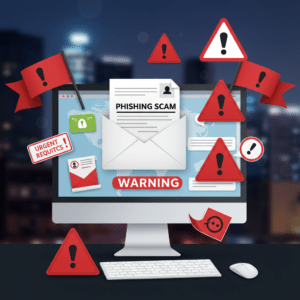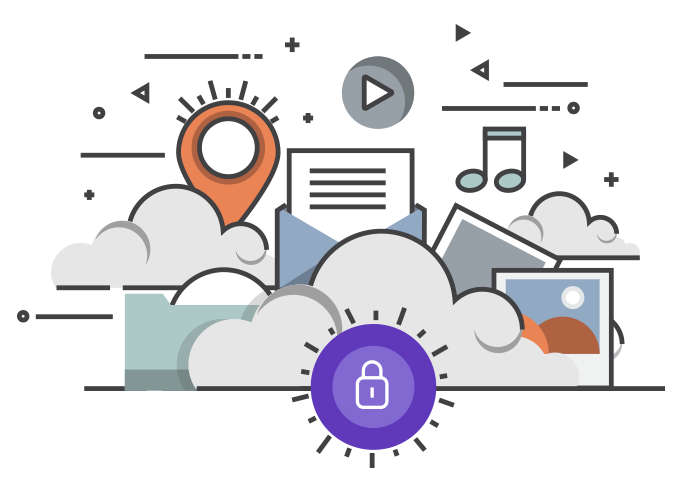💡 DIY Computer Fixes?
Grab my easy step-by-step guide and keep your computer running like new.
Slick Email Scams are Big in 2025: Is It Really From Your Bank?

In 2025, email scams have become more sophisticated than ever, making it increasingly difficult for individuals to distinguish between legitimate messages and malicious ones. Cybercriminals are refining their techniques, crafting emails that look eerily authentic, often mimicking trusted institutions like your bank. The question is, how can you tell if that email is genuinely from your bank or a cleverly disguised scam?
The Evolution of Email Scams
Email scams are not new, but their complexity has grown significantly. Early scams were often riddled with spelling errors, awkward phrasing, and obvious red flags. Today, scammers employ advanced tactics, such as replicating official logos, using domain names that closely resemble legitimate ones, and even mimicking the tone and language of official communications.
Banks, in particular, are frequent targets because they hold sensitive personal and financial information. Scammers craft emails that appear to be account alerts, security warnings, or transaction notifications—messages designed to prompt immediate action.
Common Tactics Used in Modern Email Scams
- Phishing Links: Scammers embed links that appear legitimate but direct you to fake websites designed to steal your login credentials.
- Spoofed Email Addresses: Cybercriminals use email addresses that look almost identical to your bank’s official address, often changing just one letter or adding a subtle variation.
- Urgent Call to Action: Many scam emails create a sense of urgency, warning of suspicious account activity or potential security breaches, prompting quick responses without careful consideration.
- Attachments with Malware: Some emails include attachments labeled as invoices or statements, which, when opened, install malicious software on your device.
How to Spot an Email Scam
Being able to recognize the signs of a scam email is your first line of defense. Here are some key indicators:
- Check the Sender’s Email Address: Even if the display name looks legitimate, inspect the full email address for subtle discrepancies.
- Look for Generic Greetings: Banks usually address you by name. Emails that start with “Dear Customer” or “Dear User” can be a red flag.
- Examine the Language and Tone: While modern scams have improved in quality, awkward phrasing, grammatical errors, or overly urgent tones can still indicate a scam.
- Hover Over Links: Without clicking, hover your mouse over any links to see the actual URL. If it looks suspicious or doesn’t match the bank’s official website, don’t click.
- Be Wary of Attachments: If you weren’t expecting an attachment, especially from a bank, don’t open it.
What To Do If You Suspect an Email Scam
- Do Not Click Links or Open Attachments: If anything seems off, avoid interacting with the email.
- Contact Your Bank Directly: Use a verified phone number or go directly to the bank’s official website to confirm the message’s legitimacy.
- Report the Scam: Most banks have a dedicated email address or online form for reporting phishing attempts.
- Use Security Software: Ensure your devices have up-to-date antivirus and anti-malware programs to provide an added layer of protection.
The Role of Banks in Combatting Email Scams
Many banks have stepped up their efforts to protect customers by implementing multi-factor authentication (MFA), sending alerts through official apps, and educating users about common scam tactics. However, even with these precautions, the responsibility still partially falls on individuals to stay vigilant.
Staying One Step Ahead
The best defense against email scams is knowledge. Staying informed about the latest scamming techniques and maintaining a healthy skepticism towards unexpected emails can save you from potential financial loss and identity theft.
Tips to Stay Safe:
- Regularly update passwords and use unique ones for different accounts.
- Enable multi-factor authentication whenever possible.
- Review bank statements regularly for unauthorized transactions.
- Stay informed by following cybersecurity news and updates.
Email scams in 2025 are more sophisticated than ever, but that doesn’t mean you have to fall victim to them. By understanding how these scams work and adopting proactive safety habits, you can effectively protect your personal and financial information. Always ask yourself: Is this really from my bank? If there’s even a shred of doubt, double-check before taking any action.
In the digital age, caution isn’t paranoia—it’s protection.

That Tech Jeff is an online computer repair service that offers remote and in-person help. Jeff specializes in helping beginners and seniors.
Services Computer repair, Tutoring, Virus removal, and System troubleshooting.
Features Flat rate pricing, No hourly charges, No charge if the problem can’t be fixed, Quick turnarounds, and Fair pricing with no hidden fees.
How to contact Call (805) 364-5284 and Visit That Tech Jeff
What customers say
“Finally, a computer repair guy who actually cares. 10/10!”


